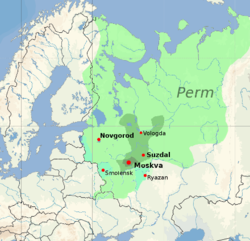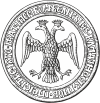
Back Grootvorstedom Moskou Afrikaans دوقية موسكو الكبرى Arabic دوقية موسكو ARZ Principáu de Moscú AST Böyük Moskva knyazlığı Azerbaijani Бөйөк Мәскәү кенәзлеге Bashkir Вялікае Княства Маскоўскае Byelorussian Маскоўскае княства BE-X-OLD Велико московско княжество Bulgarian Gran Ducat de Moscou Catalan
Principality of Moscow Grand Duchy of Moscow
| |||||||||||||||||||||
|---|---|---|---|---|---|---|---|---|---|---|---|---|---|---|---|---|---|---|---|---|---|
| 1282[1]–1547 | |||||||||||||||||||||
Double-headed eagle on the seal of Ivan III
| |||||||||||||||||||||
 Territorial expansion of the Principality of Moscow, 1300–1547 Core territory of Muscovy, 1300 Territory of Vladimir-Suzdal, acquired by Muscovy by 1390 Territory acquired by 1505 (Ivan III) Territory acquired by 1533 (Vasili III) | |||||||||||||||||||||
| Status |
| ||||||||||||||||||||
| Capital | Moscow | ||||||||||||||||||||
| Common languages | Old East Slavic, Russian | ||||||||||||||||||||
| Religion | Russian Orthodox (official)[2] | ||||||||||||||||||||
| Demonym(s) | Muscovite | ||||||||||||||||||||
| Government | Absolute monarchy | ||||||||||||||||||||
| Prince of Moscow | |||||||||||||||||||||
• 1282–1303[1] | Daniel (first) | ||||||||||||||||||||
• 1533–1547 | Ivan IV (last) | ||||||||||||||||||||
| Legislature | Veche | ||||||||||||||||||||
| History | |||||||||||||||||||||
• Established | 1282[1] | ||||||||||||||||||||
| 16 January 1547 | |||||||||||||||||||||
| Area | |||||||||||||||||||||
| 1505[3] | 2,500,000 km2 (970,000 sq mi) | ||||||||||||||||||||
| Currency | ruble, denga | ||||||||||||||||||||
| |||||||||||||||||||||
The Principality of Moscow[4][5] or Grand Duchy of Moscow[6][7] (Russian: Великое княжество Московское, romanized: Velikoye knyazhestvo Moskovskoye), also known simply as Muscovy (from the Latin Moscovia),[8][5] was a principality of the Late Middle Ages centered on Moscow. It eventually evolved into the Tsardom of Russia in the early modern period. The princes of Moscow were descendants of the first prince Daniel, referred to in modern historiography as the Daniilovichi,[9] a branch of the Rurikids.
In 1263, Daniel inherited the territory as an appanage of his father Alexander Nevsky, prince of Vladimir-Suzdal, but it was not until 1282 that Daniel is mentioned as an independent prince of Moscow.[10] Initially, Muscovy was a vassal state to the Golden Horde, paying the khans homage and tribute.[11] Moscow eclipsed and eventually absorbed its parent principality and later the other independent Russian principalities.[12] The Great Stand on the Ugra River in 1480 marked the end of nominal Tatar suzerainty over Russia,[13][11] though there were frequent uprisings and several successful military campaigns against the Mongols, such as an uprising led by Dmitry Donskoy against the ruler of the Golden Horde, Mamai, in the Battle of Kulikovo in 1380.[14]
Ivan III ("the Great") further consolidated the state during his 43-year reign, campaigning against his major remaining rival power, the Grand Duchy of Lithuania, and by 1503, he had tripled the territory of his realm. Ivan's successor Vasili III also enjoyed military success, gaining Smolensk from Lithuania in 1512 and pushing Muscovy's borders to the Dnieper. Vasili's son Ivan IV ("the Terrible") was crowned tsar in 1547.[15]
- ^ a b Kuchkin, Vladímir Andreevich (1995). Первый московский князь Даниил Александрович [The first Moscow prince, Danil Aleksandrovich]. Russian History. Vol. 1. Nauka. pp. 94–107. ISSN 0869-5687.
- ^ W. Werth, Paul (2014). The Tsar's Foreign Faiths: Toleration and the Fate of Religious Freedom in Imperial Russia. Oxford University Press. p. 147. ISBN 9780199591770.
- ^ Taagepera, Rein (September 1997). "Expansion and Contraction Patterns of Large Polities: Context for Russia" (PDF). International Studies Quarterly. 41 (3): 498. doi:10.1111/0020-8833.00053. JSTOR 2600793. Archived (PDF) from the original on 2020-07-07. Retrieved 2021-10-21.
- ^ Martin 2007, p. 208, 222, 228, 231.
- ^ a b Halperin 1987, p. 217.
- ^ A Short History of the USSR. Progress Publishers. 1965.
- ^ Florinsky, Michael T. (1965). Russia: a History and an Interpretation.
- ^ Introduction into the Latin epigraphy (Введение в латинскую эпиграфику) Archived 2021-03-10 at the Wayback Machine.
- ^ Martin 2007, p. 487.
- ^ Kuchkin, Vladímir Andreevich (1995). Первый московский князь Даниил Александрович [The first Moscow prince, Danil Aleksandrovich]. Russian History. Vol. 1. Nauka. pp. 94–107. ISSN 0869-5687.
- ^ a b Spielvogel, Jackson J. (2015). Western civilization (Ninth ed.). Stamford, CT. p. 361. ISBN 978-1285436401.
{{cite book}}: CS1 maint: location missing publisher (link) - ^ Duiker, William J. (2016). World history (Eighth, Advantage ed.). Boston, MA. p. 446. ISBN 978-1305091726.
{{cite book}}: CS1 maint: location missing publisher (link) - ^ Thompson, John M. (2019). Russia and the Soviet Union: an historical introduction second edition. Routledge. p. 73. ISBN 9781000310566.
- ^ Davies, B. Warfare, State and Society on the Black Sea Steppe, 1500–1700. Routledge, 2014, p. 5
- ^ Madariaga, Isabel de (2005). Ivan the Terrible : first tsar of Russia. New Haven, CT: Yale University Press. pp. 50–51. ISBN 9780300119732.
© MMXXIII Rich X Search. We shall prevail. All rights reserved. Rich X Search

